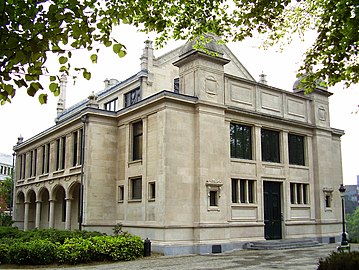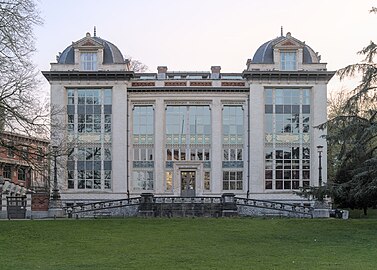Leopold Park
| Leopold Park | |
|---|---|
|
Leopold Park (
.The outstanding feature of the park is its pond, fed by the Maelbeek stream. Many rare trees (remnants of a botanic garden) and animals such as mallards, moorhens, coots, and even Egyptian geese and rose-ringed parakeets thrive in this urban environment.
History
The Eggevoorde Estate had dominated the Maelbeek valley in Brussels since the Middle Ages, but portions had been sold off in the following centuries. In 1851, a portion was sold off in exchange for shares in the Zoological and Horticultural Society, and the area became what is today Leopold Park. The park was intended to be a home for scientific and leisure activities. Horticultural gardens and a zoo were created along with a community hall, a reading room, and a café-restaurant. However, the zoo was poorly managed and the management company went bankrupt in 1876. The horticultural gardens, on the other hand, were quite successfully managed by Jean Jules Linden, and they became a commercial and scientific success story until 1898, when they were sold. The City of Brussels bought the old zoological gardens and converted them into a public recreational park containing a variety of diversions, including the current Museum of Natural Sciences.

In 1884, Ernest Solvay and Paul Héger, professors at the Université libre de Bruxelles (ULB), began a project to create an expanded university campus in the park. Several of the university's new institutes were created there, and stand to this day, including the original site of the Solvay Institute of Sociology, as well as its sister institution, the Solvay Institute of Physiology, which was completed in 1894. It was in that building that the famous Fifth Solvay Conference on Physics and on Chemistry took place in October 1927.[4]
During the following years, a campus for the
Buildings
Leopold Park contains a number of historic buildings such as the Pasteur Institute, the former
Most of the buildings were converted into offices for the
- Leopold Park buildings
-
Former Solvay Library
-
Former Solvay School of Commerce
-
Former Institute of Physiology, venue of the Fifth Solvay Conference in 1927, now the Lycée Émile Jacqmain
-
Former Eastman Dental Hospital, now the House of European History
Remarkable trees
Below are some of the park's remarkable trees listed by the Monuments and Sites Commission:[7]
| English name | Latin name | cir. in cm |
|---|---|---|
Oriental plane
|
Platanus orientalis | 586 |
Horse-chestnut
|
Aesculus hippocastanum | 444 |
European beech
|
Fagus sylvatica | 391 |
Tulip tree
|
Liriodendron tulipifera | 342 |
See also
- List of parks and gardens in Brussels
- History of Brussels
- Belgium in the long nineteenth century
References
Citations
- ^ admin (31 March 2015). "Parc Léopold". Bruxelles Environnement (in French). Retrieved 1 November 2019.
- ^ "Leopold Park". brussels.be. Archived from the original on 9 March 2012. Retrieved 18 March 2014.
- ^ "LEOPOLD PARK". sustainablecity.be. Archived from the original on 18 March 2014. Retrieved 18 March 2014.
- ^ Lorentz & the Solvay conferences, Instituut-Lorentz, Leiden University
- ^ "About The Bibliothèque Solvay". eua.be. Archived from the original on 18 March 2014. Retrieved 18 March 2014.
- ^ "Leopoldpark". europe-cities.com. Archived from the original on 18 March 2014. Retrieved 18 March 2014.
- ^ "CRMS-KCML". www.kcml.irisnet.be. Retrieved 25 May 2019.
Bibliography
- Annick Brauman and Marie Demanet, Le zoo, la cité scientifique, et la ville. Le Parc Leopold, 1850-1950 (in French), Archives d'architecture moderne, Brussels, 1985. ISBN 9782871430087
External links
 Media related to Parc Léopold/Leopoldspark at Wikimedia Commons
Media related to Parc Léopold/Leopoldspark at Wikimedia Commons- Description of Leopold Park at the Belgian Board of Tourism website




